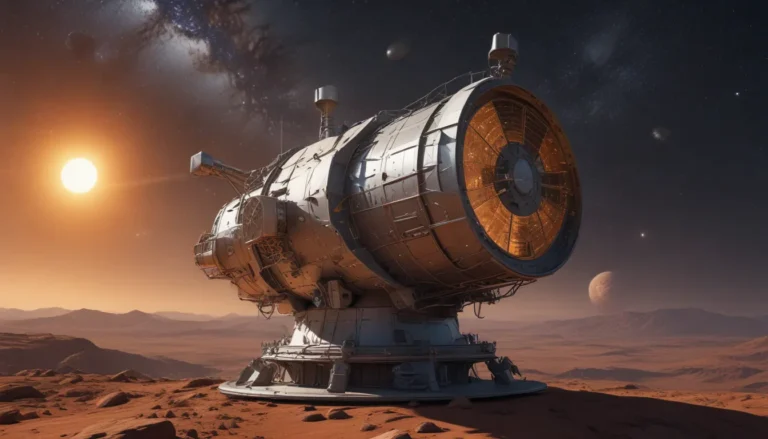The pictures we use in our articles might not show exactly what the words say. We choose these pictures to make you interested in reading more. The pictures work together with the words but don’t take their place. The words still tell you the important facts.
Space exploration has captivated the minds of people for centuries, from the launch of the first satellites to the ongoing missions to distant planets. As technology advances and more countries and private companies enter the race to explore outer space, the challenge of managing space traffic becomes increasingly important. In this article, we will explore 15 fascinating facts about space traffic management, shedding light on the complexities and significance of effectively managing the congestion in space. Get ready to embark on a journey through the world of space traffic management and discover the wonders of our cosmic neighborhood.
Understanding Space Traffic Management
Space Traffic Management (STM) serves as a crucial traffic control system for space, ensuring the safe operation of satellites and spacecraft to prevent collisions. As more objects are launched into space, STM becomes essential for maintaining order and safety in the vast cosmos. Similar to a traffic cop, STM relies on tracking, rules, and innovative technology to prevent chaos in space and preserve the sustainability of our space activities.
The Increasing Need for Space Traffic Management
The growing number of satellites in space, driven by satellite constellations and commercial space endeavors, has heightened the necessity for effective STM. With the space environment becoming more congested, STM plays a vital role in avoiding collisions and ensuring the smooth functioning of space operations.
Tracking and Monitoring Space Objects
To facilitate space traffic management, organizations like NASA and the European Space Agency meticulously track thousands of active satellites and space debris. This data is crucial for accurate monitoring of space traffic and enabling operators to make informed decisions to prevent collisions.
Collaborative Efforts for Effective Space Traffic Management
International collaborations and agreements are essential for the success of STM. By sharing data and coordinating actions, space agencies and operators can work together to ensure the safety of space operations and protect valuable space assets.
Protecting Valuable Space Assets
Space Traffic Management serves as a shield for critical space infrastructure, safeguarding services like communication, weather forecasting, and navigation systems from potential disruptions caused by collisions. By minimizing the risk of satellite collisions, STM preserves the continuity of essential services.
Ensuring Sustainability of Space Activities
Proper management of space traffic is indispensable for preventing the accumulation of space debris and minimizing its impact on future space missions. STM plays a key role in promoting responsible space behavior and preserving the sustainability of our activities beyond Earth's atmosphere.
Advancements in Space Traffic Management Technologies
Space agencies are actively developing advanced technologies to enhance STM, including automated collision detection systems, improved tracking capabilities, and enhanced data sharing mechanisms. These innovations aim to optimize the effectiveness of space traffic management and ensure the safety of space operations.
Responsible Satellite Disposal
In adherence to STM regulations, proper disposal of satellites and space debris at the end of their operational life is crucial to prevent the proliferation of space debris. Responsible satellite disposal is a critical aspect of maintaining a sustainable space environment.
Addressing the Challenges of Space Traffic Management
While space traffic management presents complex challenges, including existing space debris and the dynamic nature of the space environment, ongoing efforts are focused on developing strategies to overcome these obstacles. STM is vital for ensuring the safety of human spaceflight and protecting astronauts from potential collisions with space debris.
Extending Space Traffic Management Beyond Low Earth Orbit
Although low Earth orbit (LEO) is the most congested region of space, STM efforts extend beyond LEO to manage activities in geostationary orbit and other orbital zones. Collaboration among space agencies, private companies, and international organizations is essential for addressing the challenges posed by an increasingly crowded space environment.
The Future of Space Traffic Management
The future of space traffic management is marked by international collaborations and the development of new technologies to tackle the complexities of managing space traffic. By working together and embracing innovation, stakeholders in the space industry can navigate the intricate web of space traffic and unlock the boundless opportunities that lie beyond Earth.
Conclusion
As we venture further into the cosmos and push the boundaries of human exploration, effective space traffic management will be essential for ensuring the safety and efficiency of our missions. By following regulations, leveraging advanced technologies, and fostering international cooperation, we can navigate the challenges of space traffic and pave the way for a sustainable and prosperous future in space.
FAQs
-
What is space traffic management?
Space traffic management encompasses the processes and systems designed to regulate and monitor the movement of objects in space, including satellites, spacecraft, and debris. -
Why is space traffic management important?
Space traffic management is crucial for ensuring the safety and sustainability of space activities by preventing collisions, optimizing resource allocation, and minimizing the risk of damage to operational assets. -
How is space traffic managed?
Space traffic is managed through a combination of regulations, tracking systems, and coordination among space agencies and operators to monitor positions, predict collisions, and implement corrective measures when necessary. -
What are the challenges in space traffic management?
Challenges in space traffic management include the increasing number of satellites and debris, limited tracking resources, and the need for international coordination among different stakeholders. -
How can space traffic management be improved?
Improvements in space traffic management can be achieved through the development of advanced tracking technologies, international collaborations, stricter regulations, and guidelines for responsible satellite operations.
We hope this comprehensive guide to space traffic management has provided valuable insights into this fascinating aspect of our exploration beyond Earth. By understanding the intricacies of managing space traffic, we can better navigate the vast expanse of space and ensure a safe and sustainable future for our cosmic endeavors.






